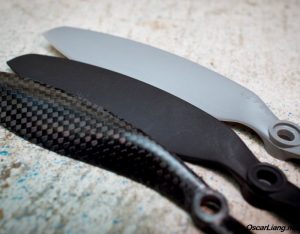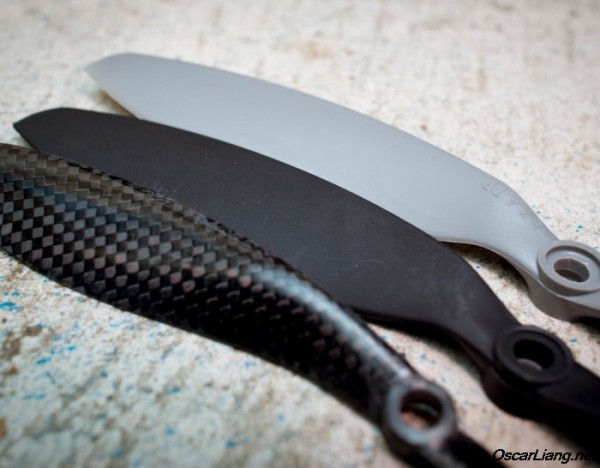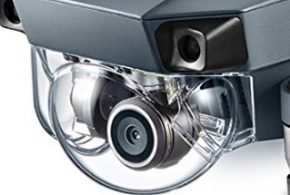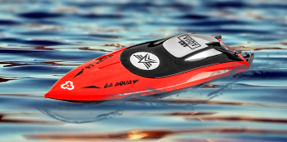Phantom Carbon Fiber Propellers – Fiber vs. Plastic

By Oscar Liang
As I have explained how to choose propellers size and pitch before, in this post we will mainly focus on the type of material, how it could affect flight performance and the value. Good props can improve your aircraft’s control-ability, increase the battery life, improve your video quality, and many other good things.

Carbon Fiber Propeller Cons and Pros
Are carbon fiber propellers better than plastic propellers? When choosing multicopter props, not only we need to consider the size and pitch of the props, we also need to choose the type of material: carbon fiber, plastic, fiber glass reinforced, wooden props etc.
Carbon fiber props are almost twice as expensive as the common plastic props, and they are promoted to have better performance than the cheap plastic ones. So is that true? What are the advantages and disadvantages of carbon fiber props? Here is what I’ve found personally.
Advantages
• Carbon fiber props produce less vibration due to their stiffness, and they are more quiet too when spinning.
• Less jello in the video.
• They are lighter and significantly stronger than plastic when crashed, but not indestructible.
• Come balanced straight out of the box (usually).
• Perform well under high RPM (work well with high KV motors).
• Light weight props mean less inertia, thus faster motor speed change, and the control feels more responsive.
Disadvantages
• Expensive!
• Carbon Fiber props have slightly shorter flight time than plastic props of the same size/pitch.
• Less thrust than plastic props.
• Because it’s tough and hard to break when crashed, the motor bearing will take most of the impact.
Experiments on Different Types of Props
Many tests have been done on how good the carbon fiber props are, compared to plastic ones. I have found people reporting back with two different stories. One says carbon fiber props are better (for example this one), the others say, no, it’s not noticeably better. I think they might be both correct, for their own situations, and the brand/make of the props they have tested. But it’s really not fair to say, “Carbon Fiber props are better”, or “Carbon Fiber props suck”, only based on the 2 sets of propellers you bought randomly off the internet.
Also the propellers need to be balanced well before the tests, otherwise it would be meaningless. I notice many of these tests were using a cell phone for vibration measuring, which is not accurate at all (as it misses some vibration frequency bands).
Wooden Props
Personally I have not tried these type or props. I don’t think wood props are popular either in the multicopter world, since they are expensive and heavy.
I think they might work well for FPV aerial photography with larger and more powerful multicopters, but might not be as good for aerobatics/stunt flying because of the increase in rotation momentum due to heavier weight that makes them less responsive to changes in motor speed.
Conclusion
In my experience CF props are better, but there are so many cheap copies which have not been properly tested that they might do more harm than good. It’s worth a trying carbon fiber propellers, so be careful when choosing and only buy from sellers good reviews.
The funny fact is that carbon fiber props are actually made of plastic based materials impregnating some carbon fiber and plastic is also carbon based. I would recommend to try CF props out if budget permits. It might improve your flight experience, but it’s not an “essential” upgrade. If you are a beginner just learning to fly, plastic props are more than good enough, as you are likely to crash and break many props before mastering the skills.
Bonus
Would you like to be a better aerial photographer of videographer? Check out this course that now only costs $49 (half off) and includes everything you need to know to be able to make gorgeous shots with your drone. Rules, regulations, flying and recording as well as tips and tricks like how to avoid pprop shadows and jello.








We have found from experimentation that vibration is a factor of propellor symmetry not so much the material its made from. Its true carbon props are more expensive so they are built more carefully but if you have vibrations carbon props can actually make it worse because they dont have the inherent damping that the fleixble plastic props provide.
Obviously, damping comes at a performance price, think of the hard suspension on a racing car, in comparison to a street sedan.
My P3 drone crashed and burned right after installing these props… DO NOT USE THEM. The machine went out of control and flew itself into the ground. If you google “phantom 3 cf prop accidents”, you will see that it’s quiet common and their use is not recommended.
Hey just curious cause the same thing happened to mine, were you using dji carbon fiber props or the cheap eBay ones, are the dji Carbon fiber props also known to have problems? Cause I was thinking of buying the dji certified.
I have been using DJI carbon fibre props. I have found that they are perfectly balanced. I have tried the cheaper Chinese one and the Phantom 3 bounced about all over the place. I have also tried three bladed props but the caused it to jump about as well. I think if DJI thought that the three blades were better our drones would come with three blades. If you are going to change your props, I reckon you should only used the DJI ones, not some cheapy type that was not made for the Phantom. It is a bloody lot of money to lose should one of the cheaper versions break.
The Aeronauts carbon fiber blades were terrible on my Blade Chroma, Three times while coming in for a landing the Machine would descend to a certain area and just drop out of the air.I would I wouldn’t recommend them in any shape or form. I have hundreds of flights on my ranch for security and fly my Chroma or Typhoon H in combination 3-5 time a day minimum ,and experience is the stock props are best,your just throwing your money away,plus you get shorter flight times and the extra performance is not noticeable to the beginner.
I installed these CF blades and when I flew it, my P4 turned upside down and started descending into the grown, luckly I gained control over it and I landed it. I’m going to remove them and put the plastic ones on.
Carbon Fiber conducts electricity. Prob why the motors and such burned out =).
I have been using CF props for the last year on several drones and never had a crash or other problem with them. Rock solid
For the new DJI Mavic Air, unfortunately the antennas are situated below the props and effect the video transmission which is lost when gaining altitude, yogh well.